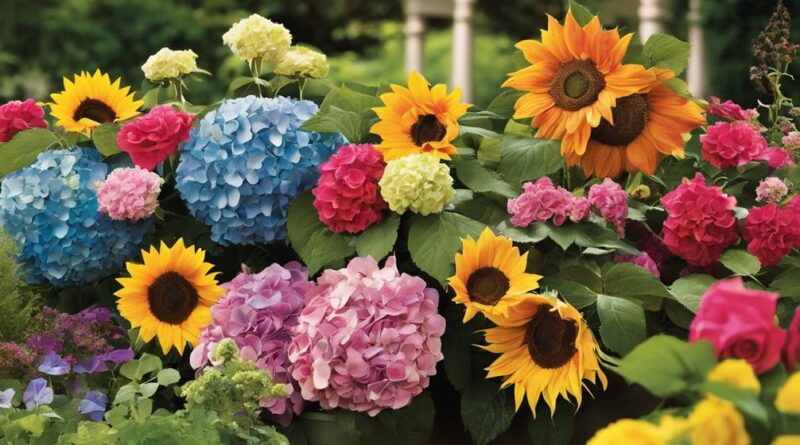Top Flower Choices for Your Home Garden
This post may contain affiliate links which means I may receive a commission for purchases made through links. As an Amazon Associate, I earn from qualifying purchases. Learn more on my Private Policy page.
Imagine your home garden as a canvas waiting to be painted with the vibrant hues of nature. Just as an artist carefully selects their palette, choosing the right flowers can transform your outdoor space into a masterpiece.
From the delicate petals of a rose to the cheerful blooms of a sunflower, each flower brings its unique charm. But which ones should you pick to create a garden that truly stands out?
Let's explore the top flower choices that will elevate your home garden to a whole new level.
Sun-Loving Flowers
When planning your garden, consider adding sun-loving flowers for a vibrant and colorful display. These flowers thrive in sunlight and can bring life to your outdoor space. To ensure your sun-loving blooms flourish, pay attention to watering tips and soil requirements. These flowers generally prefer well-draining soil, so mix some organic matter into the soil before planting to improve its quality. Water deeply but infrequently to encourage deep root growth and prevent waterlogging, especially during hot summer months.
In addition to proper watering and soil conditions, mastering pruning techniques can help your sun-loving flowers reach their full potential. Regular deadheading, the removal of spent blooms, promotes continuous flowering and keeps your garden looking fresh. When pruning, make clean cuts at a 45-degree angle to prevent damage to the plant. Furthermore, implementing pest prevention strategies is crucial to protect your sun-loving flowers from common garden pests. Keep an eye out for signs of pests like aphids or spider mites, and consider using natural remedies or insecticidal soaps to deter them.
Shade-Tolerant Blooms
Consider adding a variety of shade-tolerant blooms to your garden for a lush and vibrant atmosphere. When selecting flowers for shady areas, opt for woodland perennials that thrive in low-light conditions. These plants, such as hostas, ferns, and astilbes, not only add beauty but also require minimal sunlight to flourish. Woodland perennials are moisture-loving plants that can enhance the tranquility of your shaded garden spaces.
For indoor areas with limited natural light, consider incorporating indoor-friendly blooms like peace lilies, spider plants, or Chinese evergreens. These plants not only brighten up shady corners but also help purify the air indoors. Their ability to thrive in low-light conditions makes them perfect for rooms with minimal sunlight.
To maximize your garden space, explore vertical gardening options for shade-tolerant blooms. Hanging baskets, wall planters, or trellises can all be utilized to introduce a variety of shade-loving flowers into your garden without taking up much ground space. This technique not only adds visual interest but also allows you to grow a diverse range of plants even in shaded areas.
Low-Maintenance Floral Varieties
To maintain a flourishing garden with ease, opt for low-maintenance floral varieties that require minimal attention and care. When selecting flowers for your home garden, consider water-wise options and easy-care plants that offer high impact with minimal effort.
Water-wise options like lavender, yarrow, and sedum are excellent choices for low-maintenance gardening. These plants have adapted to thrive in drier conditions, reducing the need for frequent watering and saving you time and effort. Easy-care plants such as daylilies, coneflowers, and black-eyed Susans are also great additions to your garden. They're resilient, disease-resistant, and require little maintenance while providing beautiful blooms throughout the season.
For a garden that looks stunning without demanding too much of your time, opt for minimal effort, high-impact flowers like coreopsis, salvia, and Russian sage. These plants aren't only easy to grow but also attract pollinators, adding life and movement to your garden.
Colorful Annual Flowers
For vibrant bursts of color in your garden, choose annual flowers that will add a lively touch to your outdoor space. Annual flowers are a fantastic way to introduce a riot of colors to your garden, and they're known for their vibrant petal shades and being seasonal bloomers.
Here are some top picks to consider:
- Cosmos: With their delicate fern-like foliage and daisy-like flowers in shades of pink, white, and purple, cosmos are easy to grow and will bloom all summer long. These flowers attract butterflies and bees, adding even more life to your garden.
- Marigolds: Marigolds are a popular choice for their bright orange, yellow, and red hues. They aren't only beautiful but also act as natural pest repellents, making them a practical and colorful addition to your garden.
- Zinnias: Zinnias come in a wide range of colors, from bold reds and oranges to soft pastels and whites. These flowers are low-maintenance and can thrive in various soil conditions, making them ideal for gardeners of all skill levels.
Fragrant Flowering Plants
Fragrant flowering plants in your garden can elevate your outdoor space with their delightful scents and beautiful blooms. Consider adding aromatic herbs like lavender, rosemary, and mint to your garden. These herbs not only smell amazing but also have practical uses in cooking or making herbal teas. Lavender, with its soothing fragrance, can create a calming atmosphere in your garden retreat. Rosemary's woody scent can transport you to a Mediterranean paradise right in your backyard. Mint, with its refreshing aroma, is perfect for brightening up your outdoor space.
Scented shrubs are another fantastic addition to enhance the olfactory experience in your garden. Plants like gardenias, jasmine, and lilacs can fill the air with their sweet perfumes. Gardenias, known for their creamy white flowers and strong scent, are perfect for adding a touch of elegance to your garden. Jasmine, with its exotic fragrance, can turn your garden into a sensory oasis, especially in the evenings when its scent is most potent. Lilacs, with their nostalgic aroma, can evoke memories of springtime and add a romantic charm to your outdoor setting.
Pollinator-Friendly Blossoms
Enhancing your garden's biodiversity can be achieved by incorporating pollinator-friendly blossoms that attract bees, butterflies, and other beneficial insects. When selecting flowers for your garden, consider the following tips to create a welcoming environment for these essential pollinators:
- Butterfly attractors, garden design: Choose flowers such as butterfly bushes, coneflowers, and milkweed to attract these beautiful insects to your garden. Planting these blossoms in clusters or along pathways can create a visually appealing design that also serves as a nectar-rich buffet for butterflies.
- Bee friendly, landscaping tips: Opt for bee-friendly flowers like lavender, sunflowers, and bee balm to entice these hardworking pollinators to visit your garden regularly. Bees are particularly drawn to purple, blue, and yellow hues, so incorporating a variety of colors can help attract different bee species.
- Native plant selection: Consider incorporating native plants into your garden design, as they're well-suited to the local climate and soil conditions. Native plants not only support pollinators but also require less maintenance and watering, making them an eco-friendly choice for your garden.
Drought-Resistant Flowers

Considering the water-saving benefits of drought-resistant flowers in your garden, opt for varieties like succulents, lavender, and yarrow to thrive in arid conditions while adding beauty to your landscape. These water-saving blooms aren't only environmentally friendly but also offer a low-maintenance option for xeriscape gardening and drought-tolerant landscaping.
Succulents, known for their fleshy leaves and unique shapes, are excellent choices for dry climates. They store water in their leaves, making them resilient during periods of drought. Incorporating a variety of succulents in your garden can create a visually appealing and sustainable landscape. Lavender, with its fragrant purple blooms, is another great option for drought resistance. This herbaceous perennial not only adds a pop of color but also attracts pollinators to your garden.
Yarrow, with its feathery foliage and flat-topped flowers, is a versatile plant that thrives in dry conditions. Its ability to withstand drought makes it a valuable addition to any water-wise garden. When landscaping with succulents, lavender, and yarrow, you can create a beautiful outdoor space that conserves water and supports a thriving ecosystem. Embracing drought-resistant flowers in your garden not only saves water but also promotes sustainable gardening practices.
Long-Blooming Perennials
For a garden that stays vibrant throughout the seasons, incorporating long-blooming perennials can provide continuous bursts of color and beauty. These plants aren't only visually appealing but also low-maintenance, making them an excellent choice for any home garden.
Here are some recommendations to enhance your outdoor space:
- Cut Flower Varieties: Long-blooming perennials such as coneflowers, black-eyed Susans, and dahlias aren't only stunning in the garden but also perfect for creating beautiful floral arrangements for your home. These plants will keep your vases filled with fresh blooms all season long.
- Perennial Favorites: Consider adding classics like lavender, daylilies, and coreopsis to your garden. These perennial favorites are known for their ability to bloom for extended periods, ensuring your garden remains colorful and lively throughout the year.
- Water-Wise Plants: Opting for water-wise perennials like yarrows, sedums, and Russian sage isn't only beneficial for the environment but also for your gardening efforts. These sustainable options require less water, making them perfect for those looking to conserve resources while still enjoying a beautiful garden.
Frequently Asked Questions
Can I Plant Sun-Loving Flowers in a Shaded Area of My Garden?
You can't plant sun-loving flowers in a shaded area of your garden. Opt for shade-loving perennials instead. These plants thrive in low light conditions and will add a pop of color to your garden.
Remember to follow gardening tips to ensure your shade-loving perennials receive proper care and maintenance. With the right choice of plants and attention to their needs, your shaded garden area can still flourish beautifully.
How Often Should I Water Low-Maintenance Floral Varieties?
When caring for low-maintenance floral varieties, remember to water them sparingly to prevent overwatering. Indoor watering tips suggest allowing the soil to dry out between waterings.
Succulent care is similar, as these plants prefer infrequent watering. Adjust based on the plant's specific needs and the surrounding environment.
Are There Any Colorful Annual Flowers That Are Also Shade-Tolerant?
If you're looking for colorful annual flowers that can thrive in shade, consider some indoor options like impatiens and begonias. These seasonal favorites not only add a pop of color to shaded areas but are also relatively low-maintenance.
Remember to keep an eye on their watering needs and provide occasional fertilization for optimal growth.
With these choices, you can enjoy vibrant blooms even in the shadier spots of your garden.
What Are Some Fragrant Flowering Plants That Are Also Drought-Resistant?
Looking for fragrant flowering plants that can handle dry conditions? Consider scented succulents and water-wise aromatics.
These plants not only add a pleasant aroma to your garden but also require minimal watering. Scented succulents like lavender and rosemary are great options for both fragrance and drought resistance.
Water-wise aromatics such as Russian sage and yarrow are also excellent choices to bring scent and beauty to your garden without excessive watering needs.
Do Pollinator-Friendly Blossoms Attract Any Unwanted Pests to My Garden?
When choosing pollinator-friendly blossoms for your garden, you might wonder about attracting unwanted pests. However, many of these plants help with pest control by attracting beneficial insects that prey on garden pests.
Incorporate natural methods like planting companion flowers to deter pests. Consider garden design and color schemes that attract pollinators while minimizing unwanted visitors.
With thoughtful planning, you can create a beautiful and balanced ecosystem in your garden.
Conclusion
So, whether you have a sunny spot or a shady corner, are a beginner gardener or a seasoned pro, there are plenty of flower options to choose from for your home garden.
From low-maintenance blooms to colorful annuals, fragrant plants to pollinator-friendly blossoms, there's something for everyone.
With the right selections, you can create a beautiful and thriving garden that will bring joy and beauty to your outdoor space all season long.
Happy gardening!
